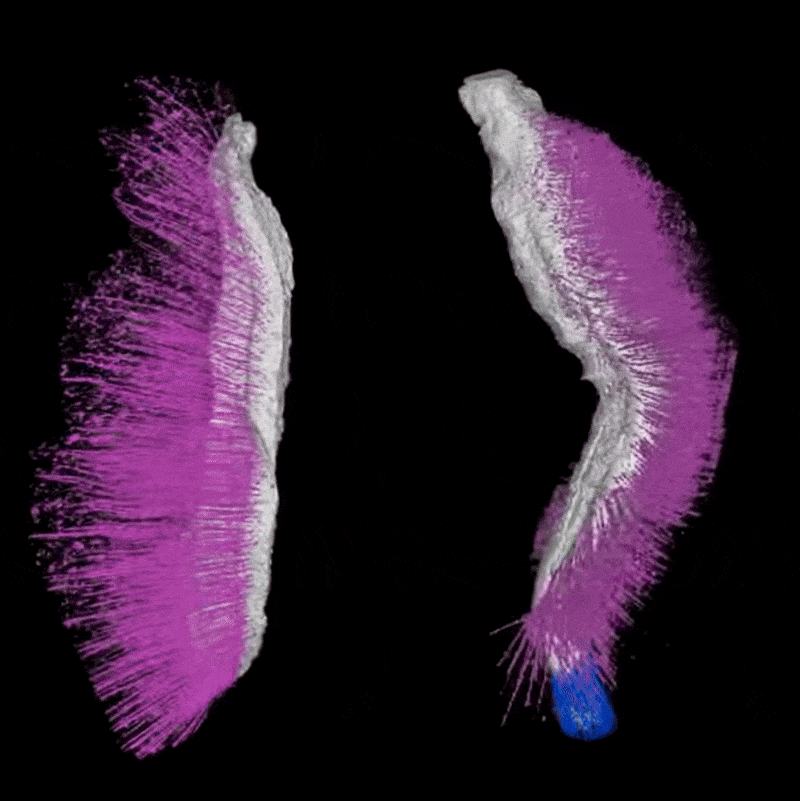Fossils
Scientists Hope This Tool Could Identify Tiny Fossils on Mars, Revealing Hints to Potential Early Life on the Planet
If Mars ever hosted microorganisms in its bygone oceans, their fossils might still be preserved in minerals—and now, we have a new potential way to find them
How a Fragile Insect Living 100 Million Years Ago Becomes a Fossil
A bug, a dinosaur and a tree intersect, creating the perfect conditions for resin to capture a moment in time
Fossil Tour Guide Discovers Giant, Purple Dinosaur Footprint While Walking Along a U.K. Beach
The roughly three-foot-long, clay print speaks to the Isle of Wight's rich paleontological history, but it will probably disappear within a couple of months due to exposure
Scientists Discover 'Groundbreaking' Jurassic Fossil That Could Overhaul the Evolutionary History of Birds
Researchers in China found Baminornis zhenghensis, which lived at roughly the same time as the famous Archaeopteryx but looked much more like modern birds due to its short tail
Rare Neck Fossil With Puncture Mark Suggests a Prehistoric Crocodilian Snacked on a Young Pterosaur 76 Million Years Ago
The fossil sheds light on interactions within the Cretaceous food web and may represent the first record of this type of predation in North America
Rare Fossil of 183-Million-Year-Old 'Sea Monster' Reveals Both Smooth and Scaly Skin
For the first time, scientists have completed an in-depth analysis of fossilized soft tissues from a plesiosaur
Paleontologists Discover Fossil of the Oldest Known Modern Bird—but It Raises More Questions Than It Answers
The fossil suggests that modern birds evolved before the dinosaur-killing asteroid, perhaps in Antarctica
Mammoth Bones Used to Build Mysterious 25,000-Year-Old Site in Russia Came From Different Herds
DNA and radiocarbon dating analyses of the bones are offering new insights into the ambitious Ice Age site constructed by hunter-gatherers
Everything You Want to Know About Dinosaur Sexual Anatomy and Reproduction, From Their Genitalia to How They Laid Eggs
Paleontologists continue to find fossils that help revise our understanding of how dinosaurs did it
Fossil Hunter Discovers 66-Million-Year-Old Vomit in Denmark, Offering a Clue to the Cretaceous Food Chain
A marine animal snacked on some sea lilies that did not agree with its stomach—and we now know what happened next
Ape-Like Human Ancestors Were Largely Vegetarian 3.3 Million Years Ago in South Africa, Fossil Teeth Reveal
Scientists suggest meat consumption was pivotal to humans' development of larger brains, but the transition probably didn't start with Australopithecus, according to a new study
Fossilized Poop Reveals How Extinct, Flightless Birds Helped Spread New Zealand's Colorful Fungi
The upland moa was likely drawn to the fungi because of their resemblance to berries, scientists say, allowing the creature to fill a role typically played by mammals
Giant, Mysterious Spires Ruled the Earth Long Before Trees Did. What Exactly Are These Odd-Looking Fossils?
For more than 150 years, scientists have debated whether Prototaxites—which stood roughly 24 feet tall and 3 feet wide—were an early lichen or fungus, like a “giant mushroom”
Rare Jaw Fossil Found in China Might Belong to the World's Smallest Cat
Scientists placed the extinct species, which may date back more than 300,000 years, in the same genus as modern leopard cats in Asia
Meet Punk and Emo, Two Angsty-Looking Fossils From 430 Million Years Ago That Shed Light on Early Mollusk Evolution
The prehistoric creatures look to be sporting a punk hairstyle and emo bangs, and one of them seemingly moved like an inchworm
Everything You Want to Know About the Sex Lives of Dinosaurs, From Scratching the Ground to Battling With Horns
By evaluating fossils, scientists are learning what creature features may have been used to attract mates and fight off sexual competitors
A Quarry Worker Felt Strange Bumps While Digging. They Turned Out to Be the Largest Dinosaur Trackway in the U.K.
The five sets of tracks represent four-legged sauropods and a three-toed carnivore that might have crossed paths on a prehistoric landscape
From Chimps Eating Medicinal Plants to Footprints Tracking Our Early Relatives, Here Are the Most Significant Human Evolution Discoveries of 2024
Smithsonian paleoanthropologists explore how the year brought us closer to understanding ancient human relatives and origins
A Homeowner Found Huge, Fossil Teeth While Mowing the Lawn. Then, Excavations Revealed a Complete Mastodon Jaw
The new discovery is the first of its kind in New York state for at least 11 years and appeared in a county rich with mastodon remains
Humans Fed Salmon to Canines 12,000 Years Ago, Study Suggests, Hinting at the Origin of Our Relationship With Dogs
New research indicates early humans and canines were interacting in the Americas 2,000 years earlier than previously thought
Page 1 of 55
:focal(700x527:701x528)/https://tf-cmsv2-smithsonianmag-media.s3.amazonaws.com/filer_public/ba/08/ba08880e-1573-4631-962e-b617f75e5f79/smithsonian_feature_image_3.png)
:focal(800x602:801x603)/https://tf-cmsv2-smithsonianmag-media.s3.amazonaws.com/filer_public/1b/f4/1bf44de2-9c64-4d5d-9b5c-750080f07fe2/korybingmosquito_web.jpg)
:focal(320x241:321x242)/https://tf-cmsv2-smithsonianmag-media.s3.amazonaws.com/filer_public/26/b8/26b8e99c-8072-42ad-ad38-b5cc34c3689d/compton_chine_-_geographorguk_-_768260.jpg)
:focal(378x528:379x529)/https://tf-cmsv2-smithsonianmag-media.s3.amazonaws.com/filer_public/97/f5/97f54d3f-3748-4bf1-99b3-473a07e63a2c/oldest_bird.jpg)
:focal(700x527:701x528)/https://tf-cmsv2-smithsonianmag-media.s3.amazonaws.com/filer_public/86/fa/86fae38c-344c-4f08-a025-0a7f183b8487/smithsonian_feature_image_1.png)
:focal(480x272:481x273)/https://tf-cmsv2-smithsonianmag-media.s3.amazonaws.com/filer_public/28/d4/28d4103d-9739-46e2-8d40-a2d193c6d668/pelsio_paddel41jpgwebp.png)
:focal(1440x905:1441x906)/https://tf-cmsv2-smithsonianmag-media.s3.amazonaws.com/filer_public/78/d7/78d7df97-3661-4aa9-9832-67ed84080587/ancient_bird_illustration.jpg)
:focal(1340x998:1341x999)/https://tf-cmsv2-smithsonianmag-media.s3.amazonaws.com/filer_public/ca/39/ca39cce1-efeb-45ef-874e-f043727714f8/1-s20-s2950236524000471-gr2_lrg.jpg)
:focal(235x126:236x127)/https://tf-cmsv2-smithsonianmag-media.s3.amazonaws.com/filer_public/02/23/02237851-edf2-4e17-babb-fcfe455bd577/muja-tyrannosaurus_web.jpg)
:focal(1024x887:1025x888)/https://tf-cmsv2-smithsonianmag-media.s3.amazonaws.com/filer_public/5a/f5/5af5dd7e-da23-4bd4-974a-17b36985085a/fossilized_vomit.jpg)
:focal(700x527:701x528)/https://tf-cmsv2-smithsonianmag-media.s3.amazonaws.com/filer_public/36/c7/36c784f2-7136-42eb-8967-be4f4cc29df9/smithsonian_feature_image.png)
:focal(956x537:957x538)/https://tf-cmsv2-smithsonianmag-media.s3.amazonaws.com/filer_public/49/3d/493dd162-cf0a-42c6-bbcf-00712c3dc432/moa_coprolite_unknown_species_from_dart_river_valley_photo_credit_janet_wilmshurst.png)
:focal(492x255:493x256)/https://tf-cmsv2-smithsonianmag-media.s3.amazonaws.com/filer_public/5d/2c/5d2cdeb9-da34-48e0-acb7-2c729e1a1b5b/prototaxites_01.jpg)
:focal(2184x1456:2185x1457)/https://tf-cmsv2-smithsonianmag-media.s3.amazonaws.com/filer_public/77/9d/779deb14-71e6-454b-b7bf-ffd19fe98594/gettyimages-453853164.jpg)

:focal(316x150:317x151)/https://tf-cmsv2-smithsonianmag-media.s3.amazonaws.com/filer_public/a6/f7/a6f78cf7-a3f6-4f02-ade0-05dd7ca65e42/gettyimages-661610512_web.jpg)

:focal(1750x1167:1751x1168)/https://tf-cmsv2-smithsonianmag-media.s3.amazonaws.com/filer_public/4c/06/4c06a91d-88ef-4210-92b3-0e3b88a0a85b/gettyimages-2191022209.jpg)
:focal(476x148:477x149)/https://tf-cmsv2-smithsonianmag-media.s3.amazonaws.com/filer_public/ba/bf/babf1232-9d64-4040-b598-78df1c1a5509/mastodontooth-jaw-tooth.jpg)
:focal(570x429:571x430)/https://tf-cmsv2-smithsonianmag-media.s3.amazonaws.com/filer_public/5d/9d/5d9d3404-e5fa-4d86-b482-8489e7ae3f22/lanoe-mandible-webjpg.webp)